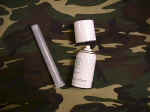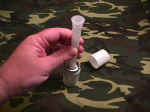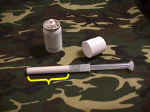|
|
Operational Obstetrics & Gynecology
Contraceptive Foam
Contraceptive foam is a good contraceptive choice for many women.
 Foam comes in a pressurized container with a plastic applicator. After placing the
aerosol container in an upright position on a solid surface, the applicator is positioned
over the top of the can and gentle downward pressure exerted. This pressure will release
foam into the applicator, gradually filling it. The applicator should be filled to the
ribbed section (about 80% full).
Foam comes in a pressurized container with a plastic applicator. After placing the
aerosol container in an upright position on a solid surface, the applicator is positioned
over the top of the can and gentle downward pressure exerted. This pressure will release
foam into the applicator, gradually filling it. The applicator should be filled to the
ribbed section (about 80% full).
 The applicator is then inserted into the vagina and the plunger depressed with the
index finger, pushing the foam into the vagina. It is immediately effective, and remains
effective for up to one hour after insertion. If intercourse is repeated, a second
applicator of foam should be used..
The applicator is then inserted into the vagina and the plunger depressed with the
index finger, pushing the foam into the vagina. It is immediately effective, and remains
effective for up to one hour after insertion. If intercourse is repeated, a second
applicator of foam should be used..
The foam will gradually leak out of the vagina over the next several hours. If douching is desired, it should not be done during the first 6 hours after intercourse, because some of the contraceptive effectiveness of the foam may be lost.
 After each use, the applicator should be washed with warm water and a mild soap. The
applicator may be disassembled for cleaning.
After each use, the applicator should be washed with warm water and a mild soap. The
applicator may be disassembled for cleaning.
The active ingredient in the foam is the standard spermicide, nonoxynol-9. This is also the material which may produce a local burning sensation in up to 20% of those using it. If the woman or her partner has this sensitivity, he or she will be sensitive to any of the nonoxynol-9 products (gel, cream, etc.).
Effectiveness is similar to that of the diaphragm. If used carefully and consistently, about 5 women out of 100 will become pregnant each year, despite the use of contraceptive foam. For the average user, failure rates are higher, about 15 or 20% each year.
*This video is an added feature, provided by the Brookside Associates Medical Education Division. It was not present in the original edition.
Home · Introduction · Medical Support of Women in Field Environments · The Prisoner of War Experience · Routine Care · Pap Smears · Human Papilloma Virus · Contraception · Birth Control Pills · Vulvar Disease · Vaginal Discharge · Abnormal Bleeding · Menstrual Problems · Abdominal Pain · Urination Problems · Menopause · Breast Problems · Sexual Assault · Normal Pregnancy · Abnormal Pregnancy · Normal Labor and Delivery · Problems During Labor and Delivery · Care of the Newborn
|
Bureau of Medicine
and Surgery |
Operational
Obstetrics & Gynecology - 2nd Edition |
 This
web version of Operational Obstetrics & Gynecology is provided by
The Brookside Associates
Medical Education Division. It contains original contents from the
official US Navy NAVMEDPUB 6300-2C, but has been reformatted for web access and
includes advertising and links that were not present in the original version.
This web version has not been approved by the Department of the Navy or the
Department of Defense. The presence of any advertising on these pages does not
constitute an endorsement of that product or service by either the Department of
Defense or the Brookside Associates. The Brookside Associates is a private
organization, not affiliated with the United States Department of Defense. All
material in this version is unclassified.
This
web version of Operational Obstetrics & Gynecology is provided by
The Brookside Associates
Medical Education Division. It contains original contents from the
official US Navy NAVMEDPUB 6300-2C, but has been reformatted for web access and
includes advertising and links that were not present in the original version.
This web version has not been approved by the Department of the Navy or the
Department of Defense. The presence of any advertising on these pages does not
constitute an endorsement of that product or service by either the Department of
Defense or the Brookside Associates. The Brookside Associates is a private
organization, not affiliated with the United States Department of Defense. All
material in this version is unclassified.
This formatting © 2006
Medical Education Division,
Brookside Associates, Ltd.
All rights reserved